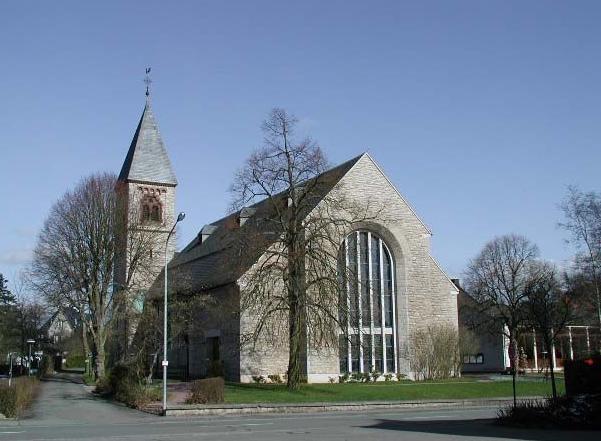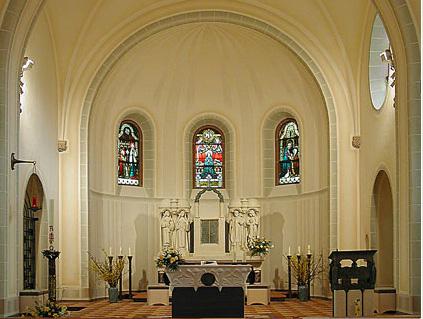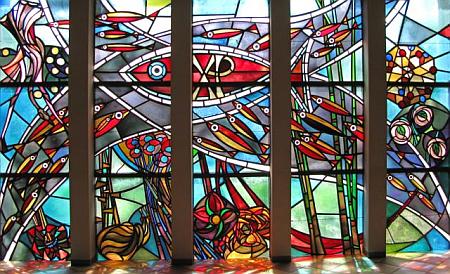StandortSachsenberger Landstr. 2
St. Marien-Kirche
The St. Marien-Kirche is the first catholic church in Korbach after the Reformation. On June, 19th, 1910 the cornerstone for the neo-romanesque church was laid with Father Möhring from Eppe according to the plans of the Langenberg brothers from Kassel. With the blessing of Father Baumeier from Arolsen on October 8th, 1911 the litte catholic community entered the house of god. The consecration of the parish church followed on July, 1st, 1915 by the suffragan bishop Hähling von Lanzenauer from Paderborn.

The first documents of a regular church service date back to the year 1860. The first catholic service was celebrated on the First Sunday in Lent in the domicile of Mrs. Josephine Schwalenstöcker (nee Neu- haus) in the house Katthagen 16. The few Catholics received their own chapel in 1877 in the house Unterstraße 5 (today parking place Waldecker Bank). The house belonged to the innkeeper Heinrich Brandt, whose wife was from Paderborn. At the same time, the Jewish community rented a room in this house, which served to celebrate the church service until the completion of the synagogue in 1895.

Until 1911 the Catholics in Korbach were attended by the priests from Eppe and by the chaplains from the estate Canisius in Nordenbeck. With the publication in the Waldecker Regierungsblatt on October 2nd, 1914, the parish of Korbach became independent. Vicar Erich Hesse, who had already been sent to Korbach by the Paderborn bishop on January 14th, 1911 as administrator of the new "mission district", was introduced as first Catholic priest after the reformation in Korbach on March 17th, 1915.
With the railway construction and the Mitteldeutsche Gummiwarenfabrik many Catholic families came from the Ruhr area and from the Eichsfeld to Korbach in order to find work here. In 1910 there were a hundred, in 1914 already 400 Catholics in the Korbach community.
With the refugees and expellees - mainly from Silesia and Sudetenland - after the Second Word War the Marienkirche became too small and had to be extended in 1858/59. In 1960 the community centre was built, which was extended in 1977/78 to become the "Haus der Gemeinde St. Marien". The rapid increase of the Catholic church community made the construction of a second house of God necessary. That was how the St. Josef-Kirche at the Eidinghäuser Weg came into being in 1966.
A similar increase experienced the community in the 1980´s and at the beginning of the 1990´s of the last century with the influx of many believers from East European countries. Today the Catholic community has about 4600 members. The St. Marien church community belongs to the Hessian part of the archbishopric Paderborn and comprises parts of the political communities of Korbach, Twistetal and Diemelsee with the daughterchurch in Adorf.

Of art-historical interest in the St. Marienkirche are the Art Nouveau windows in the presbytery with the preaching, visitation and coronation of Mary from the Lauritanian litany. A pecularity is the coloured glass window with the emblem of Korbach in the corridor between the apse and the sacristy. The glass painter Ludwig Becker from Frankfurt created the window pointing to the Sachsenberger Landstraße with the motif of three lads in the fire oven (Daniel, chapter 3) and the Christian symbols fish and XP (Christ monogram). The big altar forms the spiritual centre of the church. The well preserved statue of the virgin Mary dating from the 17th century is graceful and beautifully worked.
The metal cross that was cut out of a German-German border fence at the end of 1989 is symbolic. It relates to obstacles that man can overcome and shows the solidarity of the church community of Korbach with the twin town Waltershausen in Thuringia, which also has a similar metal cross in its church.
© Jakob Gleumes/ M. Möller
Hans Jürgen Biermann
(Grundlagen: Gemeindearchiv der kath. Kirchengemeinde St. Marien Korbach)
Literatur:
Hans Osterhold: Meine Stadt. Korbacher Bauten erzählen Stadtgeschichte, hrsg. vom Magistrat der Kreisstadt Korbach, 3. Aufl., Korbach 2004.